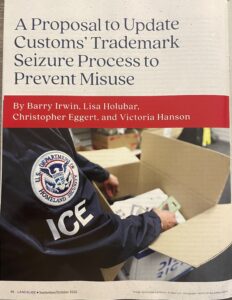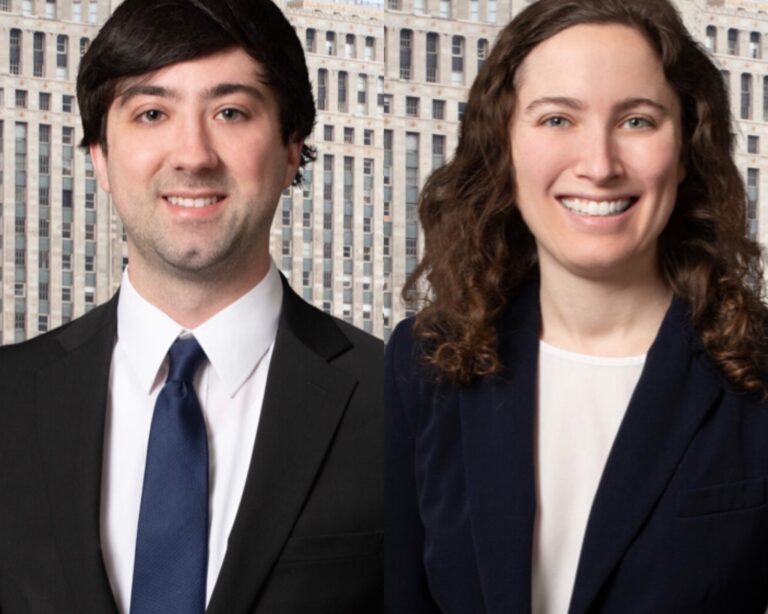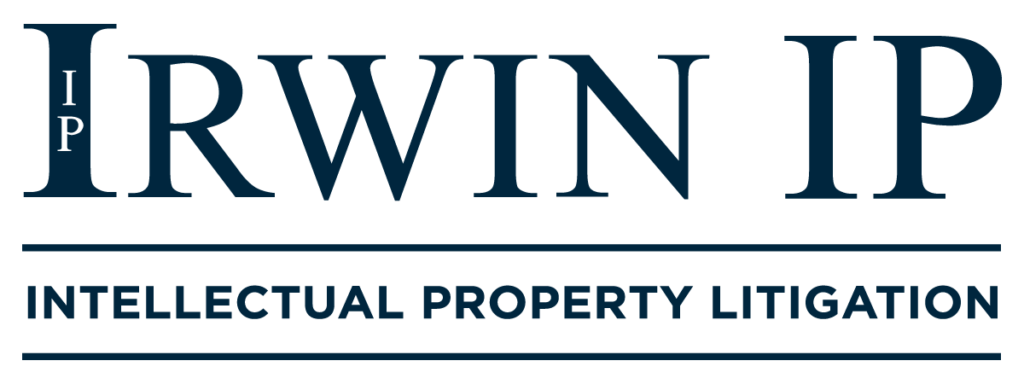The Court of Appeals for the Federal Circuit (“CAFC”) recently affirmed in part, vacated in part, and remanded a Patent Trial and Appeal Board (“PTAB”) decision holding that all but two claims of a patent belonging to Provisur Technologies, Inc. (“Provisur”) were unpatentable as obvious. In doing so, the CAFC upheld the PTAB’s decision to allow the petitioner for Inter Partes Review (“IPR”), Weber, Inc. (“Weber”) to introduce evidence for the first time in its reply because doing so was responsive to Provisur’s arguments and because Provisur was not unfairly prejudiced by admission of the evidence.
Weber filed an IPR petition challenging U.S. Patent No. 6,997,089 (the “’089 patent”) which is directed towards a system that uses conveyor belts, slicers, and other devices to arrange slices of food products such as bacon or deli meat based on an optical image of the slice. In the petition, Weber argued that one of its prior art references disclosed a camera that could be “of any known type” and therefore taught the digital camera claimed in the ’089 patent. Provisur argued in its response that because the prior art specifically taught an analog-to-digital converter separate from the camera, it did not teach a digital camera as claimed by the ’089 patent. Weber replied by providing additional evidence of ELECTRIM digital cameras as described in the prior art including both documentation and an expert declaration. Provisur deposed Weber’s expert declarant, obtained admissions that the ELECTRIM cameras were known to Weber prior to the filing of the petition, and moved to exclude this additional evidence for violating both Federal Rule of Evidence 403 and the PTAB’s rules with its untimely submission. But, the PTAB denied Provisur’s motion and found the challenged claims unpatentable based in part on the ELECTRIM evidence. The CAFC upheld this decision.
First, the CAFC held that the PTAB did not abuse its discretion in finding that Weber did not improperly withhold the ELECTRIM evidence, reasoning that Provisur “conflate[d] capability with obligation.” Weber’s petition established a prima facie case of obviousness. The ELECTRIM evidence submitted in reply by Weber was in response to arguments made by Provisur that the prior art did not disclose a digital camera by providing evidence that the prior art used the same type of camera as the ‘089 patent. The CAFC agreed with the PTAB that such responsive evidence necessarily fell outside the scope of Weber’s evidentiary burden for its petition so it was immaterial when this evidence could have been disclosed. Second, the CAFC held that the PTAB did not abuse its discretion in finding a lack of prejudice to Provisur in the late disclosure of the ELECTRIM evidence. As the evidence was partially dispositive, the evidence was highly probative and under the balancing test of FRE 403 was not outweighed by any unfair prejudice to Provisur. And to address any potential prejudice, Provisur did have time to depose and cross examine Weber’s expert and was permitted to file a sur-reply.
As this case is an affirmance that reviewed the PTAB merely for abuse of its discretion, it is unclear if the CAFC would have found the same had the PTAB granted Provisur’s motion to exclude. Whichever way you slice it, petitioners before the PTAB should still disclose all known probative evidence with their petitions even if it is clear that they need not be clairvoyant of the arguments that the patent owner will make it response.
This week, the Court of Appeals for the Federal Circuit (“CAFC”) affirmed the invalidity of Polaris Innovations Ltd.’s (“Polaris”) previously-invalidated patents, despite previously vacating and remanding the invalidity decisions.
In February of 2017, NVIDIA Corporation (“NVIDIA”) initiated two inter partes review (“IPR”) proceedings to challenge validity of two patents owned by Polaris and directed to computer memory: U.S. Patent Nos. 6,532,505 (“the ’505 patent”) and 7,405,993 (“the ’993 patent”). The Patent Trial and Appeal Board (“PTAB”) invalidated the two patents on December 19, 2018, finding all challenged claims unpatentable. During appeal of the decisions to the CAFC, Polaris and NVIDIA settled, resulting in NVIDIA’s withdrawal from the appeals. The Patent Office (“USPTO”) subsequently intervened to defend the PTAB’s decisions. But shortly before appellate argument, the CAFC also declined to rehear Arthrex Inc. v. Smith & Nephew, Inc., 941 F.3d 1320 (Fed. Cir. 2019) (“Arthrex I”) en banc, prompting the CAFC to implement its holding in Arthrex I. Specifically, Arthrex I found that the PTAB judge (“APJ”) appointments were unconstitutional for lack of oversight from the director of the USPTO. As a result, Arthrex I also required the CAFC, on remand, to vacate decisions and grant a new hearing with a new panel of APJs. Accordingly, in May 2020, the CAFC also vacated the PTAB’s decisions invalidating the ’505 and ’993 patents and remanded the proceedings to be heard by a new panel of APJs.
However, since Arthrex I was subject to potential Supreme Court action, the PTAB suspended its reconsideration of the IPRs. During the suspension, in June of 2020, Polaris and NVIDIA filed a joint motion to terminate the proceedings, in light of Polaris’s and NVIDIA’s settlement. The Supreme Court then vacated the Arthrex I decision in 2021, changing the remedy initially required by the CAFC. United States v. Arthrex, Inc., 141 S. Ct. 1970 (2021) (“Arthrex II”). Arthrex II now (1) vacated any vacatur stemming from Arthrex I, and (2) allowed parties to seek director review. Accordingly, per the CAFC, the original PTAB finding of invalidity of the ’505 and ’993 patents became the controlling final written decision. And 35 U.S.C. § 317 provides in relevant part:
An inter partes review instituted under this chapter shall be terminated with respect to any petitioner upon the joint request of the petitioner and the patent owner, unless the Office has decided the merits of the proceeding before the request for termination is filed.
As the PTAB successfully argued, the now-reinstated decision of invalidity rendered any joint motion to terminate untimely, supporting the PTAB’s denial of the motion. Accordingly, Polaris’s patents ended this week as invalid, ending the inquiry into the validity of its patents, as Polaris sought director review, the relief provided by Arthrex II, and was denied. Perhaps this case serves as a lesson to parties to willingly settle earlier, before subjecting the validity of patents to the roller coaster and expense of appellate courts and the relatively short lifespan of patent jurisprudence.

Yesterday, Irwin IP sponsored and participated in the Linn Inn’s 8th Annual Mark T. Banner Scholarship fundraising event and golf/social outing. We sent our top female attorneys to play in the outing, here are some pics they shared from the beautiful day. Great job, ladies and congrats to The Linn Inn on another successful fundraising event!
On September 7, 2022, the Federal Circuit (CAFC) affirmed dismissal of a patent infringement suit under the duplicative litigation doctrine because the asserted patent and accused products were part of an earlier filed case. Arendi S.A.R.L. (“Arendi”) filed suit against LG Electronics Inc. and LG Electronics USA, Inc. (collectively, “LG”) in the District of Delaware asserting that numerous LG products infringed U.S. Patent No. 7,917,843 (“the ‘843 patent”). The Delaware local rules required Arendi to identify in its infringement contentions the accused products, the asserted patent, and claim charts for each accused product. Arendi identified hundreds of LG products as infringing the ‘843 patent, but Arendi included a claim chart for only one product, LG’s Rebel 4 phone (“Rebel”), which was marked as “exemplary.”
LG informed Arendi that its single product claim chart was insufficient and, therefore, understood Arendi’s contention to be limited to the Rebel. The parties agreed on eight representative products to represent all of the accused products; one of which was the Rebel. LG provided discovery on all eight representative accused products, but LG also maintained its position that Arendi’s single product claim charts were insufficient and that Arendi needed to provide claim charts for the other exemplary products. Despite LG’s position, Arendi did not supplement its infringement contentions prior to the close of fact discovery. Instead, Arendi provided its expert report with infringement contentions for five of the seven non-Rebel representative products.
LG moved to strike the portions of Arendi’s expert report related to the five additional non-Rebel products. The District Court granted the motion because Arendi had not timely disclosed its contentions with respect to those five products during fact discovery. Instead of trying to amend its contentions, Arendi filed a second suit accusing the non-Rebel products of infringing the ‘843 patent. LG moved to dismiss the second suit as duplicative, which the District Court granted. Arendi appealed.
On appeal, the CAFC considered whether the District Court appropriately dismissed the second suit under the duplicative-litigation doctrine, which prohibits plaintiffs from having “two separate actions involving the same subject matter at the same time in the same court . . . against the same defendant.” Arendi argued that the cases were not duplicative because there was no overlap in accused products due to the District Court’s striking of its expert report opinion on the five non-Rebel products. The CAFC rejected this argument because Arendi listed the non-Rebel products in its infringement contentions and conducted discovery aimed at those products. In fact, the CAFC could not find any basis for Arendi’s position that the non-Rebel products were not part of the first case. The CAFC explained that the District Court did not exclude the non-rebel products because they were not accused, but rather because Arendi failed in its discovery obligations with respect to those products to provide infringement contentions during fact discovery.
This opinion demonstrates the dangers of relying on exemplary products and the importance of supplementing contentions during fact discovery. Many courts, like the one here, are not going to let parties neglect their discovery obligations without consequences.
Pointing to domain registration, hosting services, website compliance terms, and U.S. based users of a Hong Kong company’s internet business, the Ninth Circuit reversed dismissal of a Japanese company’s copyright suit for a lack of personal jurisdiction. This precedential decision provides guidance regarding what constitutes sufficient jurisdictional contacts to establish that a defendant “expressly aimed” and foreseeably anticipated suit in the forum under the federal long-arm statute. The case was remanded for analysis of fair play and substantial justice under Fed. R. Civ. P. 4(k).
Will Co., Ltd. (“Will Co.”) is a Japanese adult entertainment company that exclusively provides access to its U.S. copyright registered videos via a single website. Will Co. sent take-down notices under the Digital Millennium Copyright Act (“DMCA”) to a website providing Will Co.’s content. When the content was not removed, Will Co. filed suit, identifying after limited discovery the site’s corporate owner and director (collectively, “Defendants”). The District Court granted Defendants’ motion to dismiss, finding that operation of the site was indistinguishable from facts in AMA Multimedia, LLC v. Wanat, 970 F.3d 1201 (9th Cir. 2020), as the website was not “expressly aimed” at the U.S. and significant harm did not exist where only 4.6% of site viewers were in the U.S.
The Ninth Circuit reviewed the lower court’s due process analysis, which required that International Shoe’s minimum contacts and fair play and substantial justice were met. This required Will Co. to show Defendants “purposefully directed” activities to the forum, relatedness of the suit to the contacts, and reasonableness. For the first prong the Ninth Circuit applied the Calder Effects Test and asked whether factors of an intentional act, expressly aimed at the forum and causing likely harm, supported purposeful direction. Domain name and privacy service purchases, the Ninth Circuit found, were intentional acts. Although a closer question, and noting passive sites alone are insufficient, the Court found Defendants also “expressly aimed” their site to the U.S. by analogizing these facts to Mavrix Photo Inc. v. Brand Techs., Inc., 647 F.3d 1218 (9th Cir. 2011) and distinguishing AMA. Like the California-related stories and ads in Mavrix that showed the website was meant to appeal to and profit from consumers in the relevant forum, the Defendants here profited from an advertising structure that evidenced an intent to cultivate a U.S. audience. Hosting content in Utah and use of a network that sped up U.S. content delivery, the Court said, showed intent to appeal to U.S. consumers as well as web page compliance guarantees and English terms limited to the U.S. Although just 4.6% of site views were in the U.S., the Ninth Circuit determined the 1.3 million visits showed sufficient harm was foreseeable where Defendants were aware of profits from U.S. viewers of content.


We are pleased that the American Bar Association’s Landslide Magazine (September/October 2022 issue) published our article: “A Proposal to Update US Customs’ Trademark Seizure Process to Prevent Misuse.” The article was written by IIP’s Barry Irwin, Lisa Holubar, Victoria Hanson, and IIP alum Chris Eggert. You can see the full article on pages 46-51.
On August 23, 2022, the Federal Circuit (“CAFC”) rejected an attack on the Alice/Mayo patent eligibility framework (“Alice/Mayo”), finding it was sufficiently defined based on judicial precedent to be usable in practice, was not arbitrary and capricious under the Administrative Procedure Act (“APA”) as the APA does not apply to courts, and did not violate the Due Process Clause of the Fifth Amendment.
Jeffrey A. Killian (“Killian”) filed U.S. Patent Application No. 14/450,042 which was rejected by a patent examiner pursuant to § 101 as the claims were found to be directed to an abstract mental process and recited generic computer functionalities. The application related to a system and method “for determining eligibility for Social Security Disability Insurance [SSDI] benefits through a computer network.” The Patent Trial and Appeal Board (“the PTAB”) affirmed and Killian appealed.
On appeal, the CAFC explained that under the Supreme Court’s decisions in Alice and Mayo there is a two-step test for determining whether a claimed subject matter is patent eligible. First, the court determines whether the “claims at issue are directed to a patent patent-ineligible concept,” such as an abstract idea. If the first step is satisfied, courts then “examine the elements of the claim to determine whether it contains an inventive concept sufficient to transform the claimed abstract idea into a patent-eligible application.” The CAFC affirmed the PTAB’s decision, finding there was substantial evidence that Killian’s claims were abstract mental processes and used generic computer functionalities without any inventive concept. The CAFC then addressed Killian’s arguments regarding § 101 jurisprudence.
Killian first argued that the Alice/Mayo framework (“Alice/Mayo”) is indefinite and any PTAB decision finding a claim ineligible under Alice/Mayo is arbitrary and capricious under both the APA and the Due Process Clause of the Fifth Amendment. Killian sought a “single non-capricious definition or limiting principle” to replace the allegedly vague terms of “abstract idea” and “inventive concept.” The CAFC rejected Killian’s due process argument because he did not argue how Alice/Mayo was void-for-vagueness. Next, the CAFC held that the APA’s standards of review only apply to administrative agencies and that courts are not agencies. Additionally, while noting there was no “hard-and-fast” rule for the abstract idea exception to § 101, the CAFC found judicial precedent provided practical guidance as to what is considered an “abstract idea” and an “inventive concept.” The CAFC explained the courts are bound by the Alice/Mayo framework.
The CAFC also rejected Killian’s other § 101 arguments. Killian argued his due process rights were violated as he could not appear in previous CAFC and Supreme Court § 101 cases, however, the CAFC held there was no violation as Killian was free to distinguish his invention from the claims in previous § 101 cases. Next, Killian argued the “inventive concept” step is improper as Congress removed the “invention” requirement in the Patent Act of 1952. The CAFC found that Killian did not provide an argument that “invention” is the same as “inventive concept” and rejected the argument. Killian further argued the phrase “mental steps” had no foundation in modern patent law, but the CAFC rejected this argument by pointing to the Supreme Court’s decision in Mayo which explicitly uses that phrase.
This decision will likely dampen efforts to dramatically change the Alice/Mayo framework at the CAFC and district court levels as the CAFC seems intent on sticking with Alice/Mayo until the Supreme Court reverses itself or until Congress revises the patent statute.

Irwin IP is pleased to welcome Alexander Bennett and Ariel Katz to our team. Both Alex and Ariel worked as Summer Associates in 2021 and continued to assist the firm as part – time law clerks during their 3L year. This Spring, Alex graduated from Chicago – Kent College of Law and Ariel graduated from Loyola University Chicago School of Law. Please join us in welcoming Alex and Ariel!
Irwin IP LLC is pleased to announce that 3 lawyers have been included in the 2023 edition of The Best Lawyers in America®. Since it was first published in 1983, Best Lawyers has become universally regarded as the definitive guide to legal excellence.
“Best Lawyers was founded in 1981 with the purpose of highlighting the extraordinary accomplishments of those in the legal profession,” said Best Lawyers CEO Phillip Greer. “We are proud to continue to serve as the most reliable, unbiased source of legal referrals worldwide.”
Best Lawyers has earned the respect of the profession, the media, and the public as the most reliable, unbiased source of legal referrals. Its first international list was published in 2006 and since then has grown to provide lists in over 75 countries.
Lawyers on The Best Lawyers in America list are divided by geographic region and practice areas. They are reviewed by their peers based on professional expertise and undergo an authentication process to make sure they are in current practice and in good standing.
Irwin IP LLC would like to congratulate the following lawyers named to the 2023 The Best Lawyers in America list:
- Reid Huefner – Patent Law
- Jason Keener – Litigation – Intellectual Property
- Barry F. Irwin – Copyright Law, Litigation – Intellectual Property, Litigation – Patent, and Patent Law

